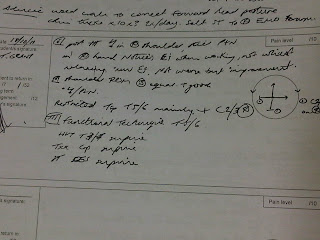Learning for Professional Autonomy
The thoughts of a student osteopaths final year
https://www.facebook.com/T.Grant.Personal.Training
Friday, 11 May 2012
Thursday, 10 May 2012
Sports Rehabilitation
Attending a talk by David Tiberio in October gave me a new insight into how to rehabilitate a patient looking to return to normal function, let a lone returning to sporting function. Tiberio discussed about loading and exploding, explaining that in order to carry out any movement, a small opposite movement occurs first. For example, when getting out of a seat, you almost sit deeper into your chair, loading the muscles needed to get you out of the chair (quadriceps, gluts etc) by applying a small stretch. This enables them to explode allowing you to carry out the movement of getting out of the chair.
I also completed a course held by Robin Lansman on Sports biomechanics and muscle chains. Here we looked at developing the standing exam, the squat test, muscle chains (open and closed chains), sport muscle chains.
I was fortunate enough to have a patient who presented with multiple inversion ankle sprains. Using these two tools, along with my knowledge as a personal trainer I carried out some rehabilitation exercises on this patient. An example of the notes can be seen below.
Certificate of the CPD course
Gait analysis
in my attempt to grasp a better understanding of gait mechanics and how it could affect a patient I attended a Manus Sinistra talk held by Matt Harris. I also observed Matt Harris at Pure Sports Medicine, seeing him implement this into all his treatments with his patients. He also advised his patients on nutrition further strengthening my want to get a general better understanding on appropriate nutritional advice. Below are pictures of Matt assessing a fellow BSO student's gait, and my assessments of my patients gait in clinic.
Functional technique practise and clinical application
some pictures of me practising tapping the spinal segments of the thorax and moving the segment into its greatest point of ease.
clinic notes of me applying functional technique in clinic on patients, incorporating this into my routine where possible and approriate.
Obstetrics technique practise
Below are my attendance forms to my lectures in obstetrics and osteopathy,

Applying the technique used to assess leg length discrepancy with a patient,
the diaphragm release/stretch technique - which can be applied to pregnant women and can be beneficial due to the poor mechanisms of the diaphragm resulting from pregnancy and pressure/restriction produced due to the foetus
the 8 finger soft tissue technique
modified posterior SIJ high velocity thrust - as a pregnant woman would not be able to roll on to her front to carry out this technique
seated soft tissue of the erector spinae muscles - effective and removes the need for the patient to lie prone as the patient would be pregnant and unable to do so
periscapular muscles soft tissue, using the patients arm to reinforce and direct treatment to specific tissues, muscles and articulation of the shoulder complex
IMS practise and clinical application
Involuntary Movement System practise, attendance and clinical practise. I recently had a headache patient and have applied frontal lift technique in order to elevate his symptoms. There has been an improvement as he has been able to have no headache post treatment for upto 3 days. Prior to treatment the patient would suffer from headaches on a daily occurance.
I attempted to perform balance tension at the sacrum on a patient who experienced pain shooting along her sacrum. She had adhesions removed and this also gave me an opportunity to attempt this technique in order to see if this would relieve her symptoms.
Study Group
We work hard to ensure we can think of all differential diagnoses, he is a little picture of me with the work my study group and I did on the knee and the mechanism behind high velocity thrusts
Subscribe to:
Comments (Atom)





.jpg)



.jpg)
.jpg)
.jpg)


.jpg)
.jpg)
.jpg)
.jpg)



.jpg)


.jpg)



